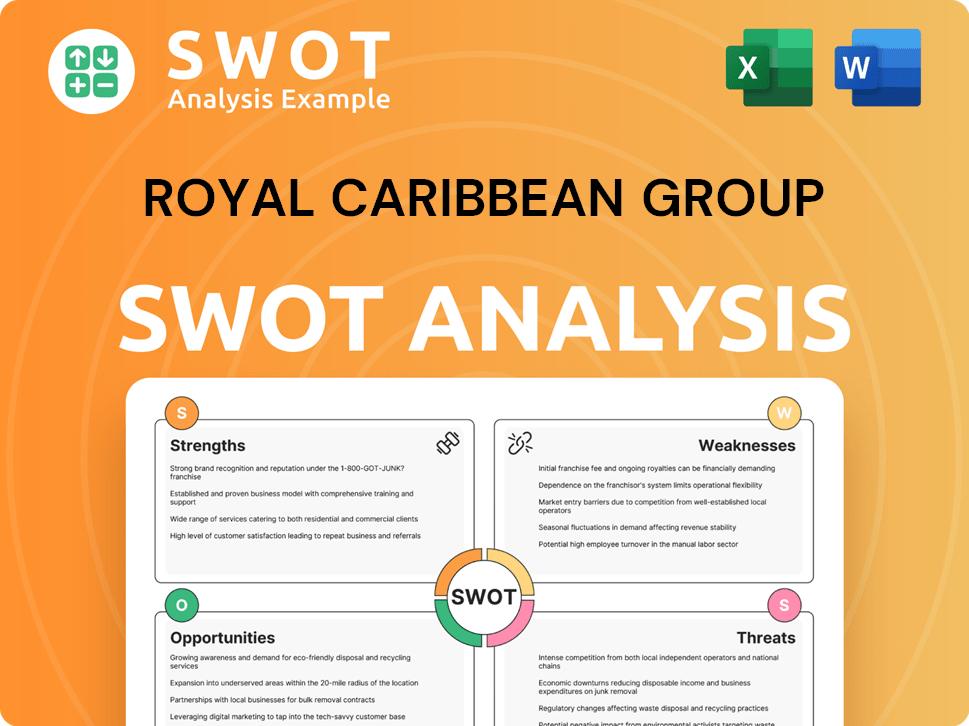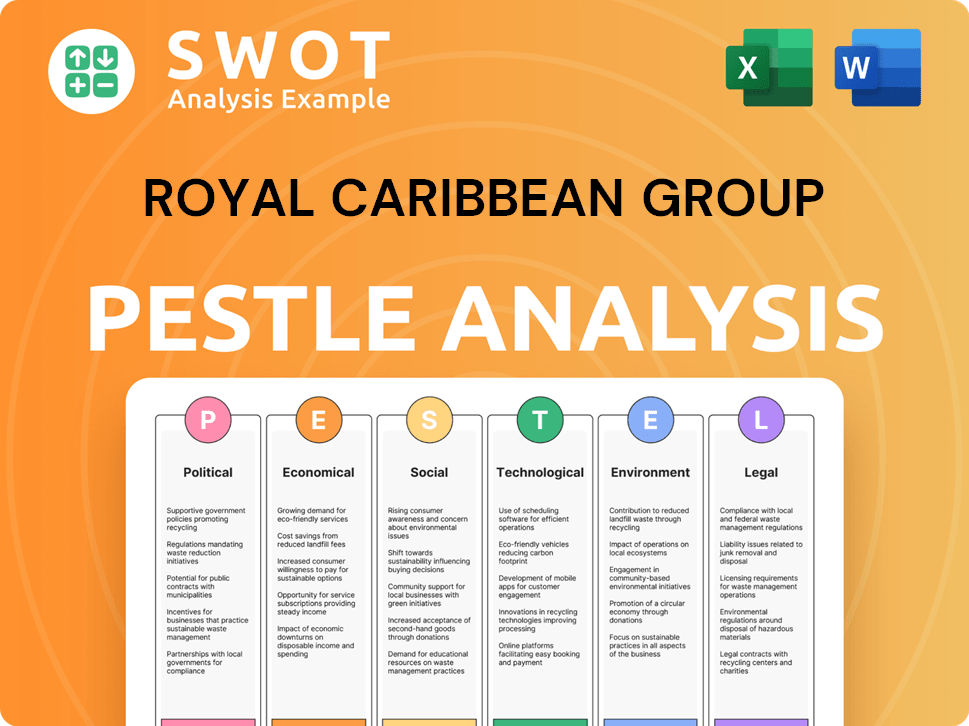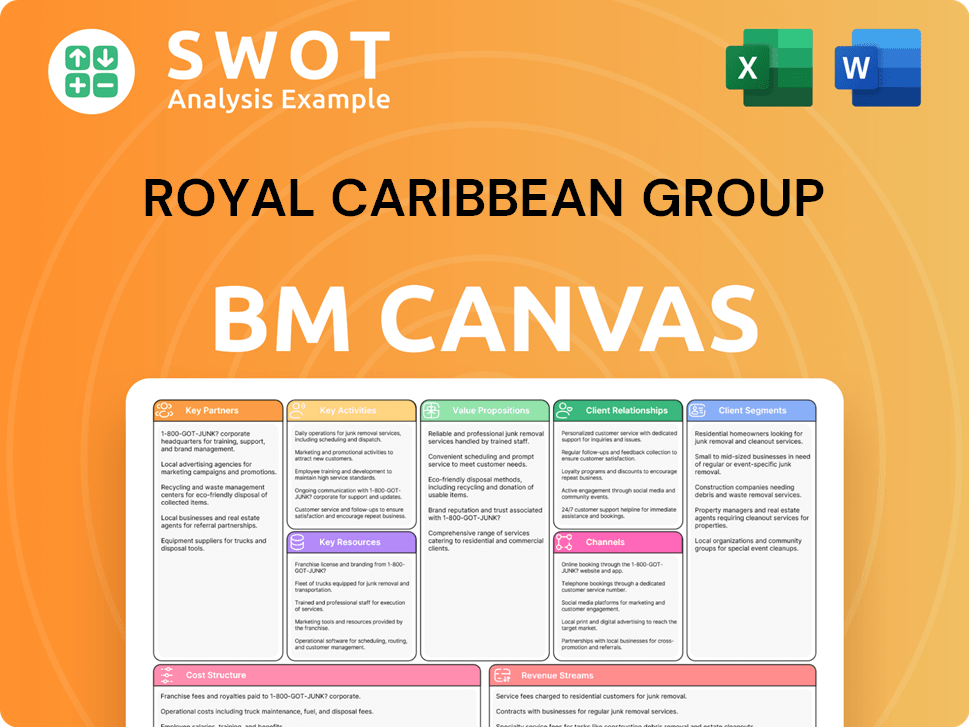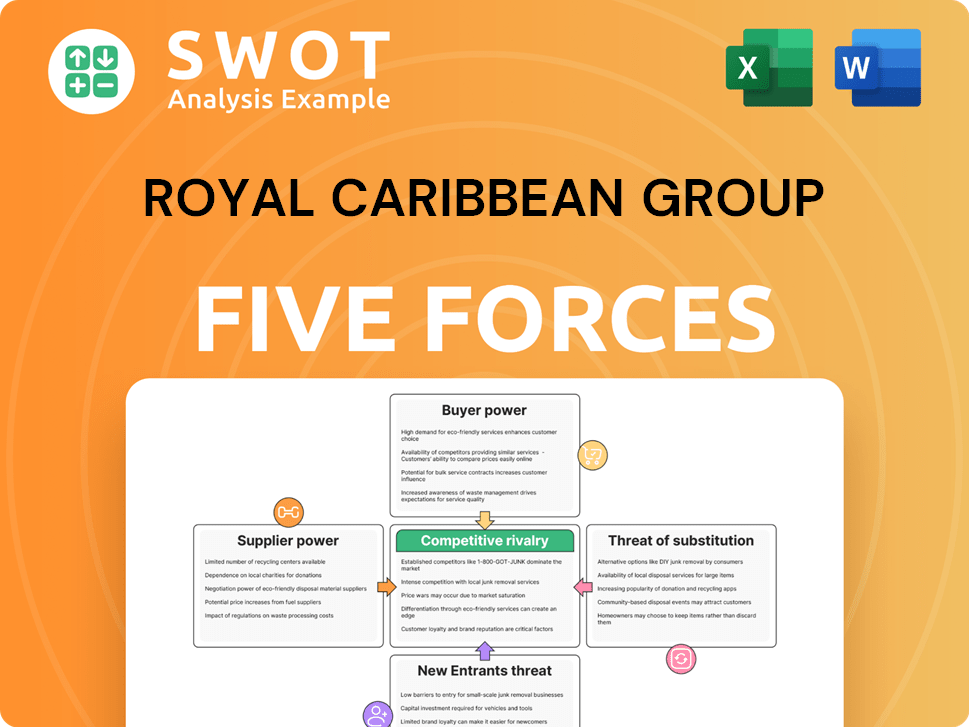Royal Caribbean Group Bundle
How Does Royal Caribbean Group Navigate the Seas of Sales and Marketing?
Royal Caribbean Group has redefined the cruise experience, moving beyond traditional perceptions to attract a new generation of cruisers. Their 'Come Seek' campaign, launched in 2015, showcases a commitment to adventure and unique experiences. This strategic shift has positioned them as a leader in the competitive cruise industry.

This deep dive explores the Royal Caribbean Group SWOT Analysis, examining how they effectively reach customers through diverse sales channels and marketing tactics. We'll uncover their brand positioning, recent campaigns, and the strategies behind their impressive financial performance, including 2024's $16.5 billion revenue. Learn about their cruise marketing, sales and marketing in travel, and overall cruise line strategy to understand their continued success and projected growth into 2025.
How Does Royal Caribbean Group Reach Its Customers?
The sales strategy of the Royal Caribbean Group (RCL) is built on a multi-channel approach, combining online and offline methods to reach a global customer base. This strategy includes company websites, a vast network of travel agencies, and direct sales teams accessible via call centers. The company's strategy focuses on providing a seamless booking experience through its digital platforms.
The company's online platforms offer full digital booking capabilities, making the e-commerce experience easier for customers. The evolution of these channels has seen a significant shift towards digital adoption and omnichannel integration. This includes optimizing its website and content for search engines (SEO) to improve online visibility and attract organic traffic. The company also utilizes mobile applications to enhance digital accessibility for bookings and onboard services.
Strategic partnerships are a core part of the Royal Caribbean Group's distribution strategy. Collaborations with travel agencies and tour operators allow the company to reach wider audiences and attract new customers who might not have previously considered a cruise vacation. These partnerships also enable Royal Caribbean Group to offer exclusive deals and promotions. This comprehensive approach to sales channels has contributed to Royal Caribbean Group holding a significant market share in the global cruise industry.
The company's websites are a primary sales channel, offering full digital booking capabilities. This allows customers to easily browse and book cruises. Digital platforms are optimized for search engines to enhance online visibility and attract organic traffic. The company has invested in its digital presence to improve the customer experience and drive sales.
Royal Caribbean Group works with over 68,000 global travel agency partners. These partnerships are crucial for reaching a wider audience and attracting new customers. The company provides partners with tools and resources to promote and sell cruises. These partnerships are key to the company's sales and marketing in travel strategy.
Direct sales teams, accessible via call centers, offer personalized service and support. These teams assist customers with bookings, inquiries, and after-sales service. This channel provides a direct line of communication with customers and helps build relationships. The direct sales teams are an important part of the Royal Caribbean sales strategy.
Mobile applications enhance digital accessibility for bookings and onboard services. With 4.2 million annual users, the app provides a convenient way for customers to manage their cruise experience. The app supports the company's digital marketing strategy by providing a platform for direct engagement and promotions. The app contributes to the overall customer relationship management.
These sales channels are supported by targeted marketing campaigns designed to reach specific customer segments. The company uses various advertising strategies, including digital marketing, social media marketing, and traditional advertising, to promote its cruises. The company's brand positioning is focused on offering innovative and memorable cruise experiences. For more details, you can explore the Revenue Streams & Business Model of Royal Caribbean Group. As of Q1 2025, Royal Caribbean Group held a market share of 27.46% in the global cruise industry, demonstrating the effectiveness of its sales and marketing efforts.
The Royal Caribbean Group's sales strategy is built on a multi-channel approach, integrating online and offline methods. This strategy includes company websites, a vast network of travel agencies, and direct sales teams accessible via call centers. The approach focuses on providing a seamless booking experience through its digital platforms.
- Digital Focus: Emphasizes online platforms and mobile applications to enhance customer engagement and bookings.
- Partnerships: Leverages a global network of travel agencies and tour operators to expand reach and offer promotions.
- Customer Relationship Management: Focuses on personalized service and building relationships through direct sales teams and mobile apps.
- Market Segmentation: Targets specific customer segments with tailored marketing campaigns and advertising strategies.
Royal Caribbean Group SWOT Analysis
- Complete SWOT Breakdown
- Fully Customizable
- Editable in Excel & Word
- Professional Formatting
- Investor-Ready Format

What Marketing Tactics Does Royal Caribbean Group Use?
The marketing tactics of the Royal Caribbean Group are multifaceted, aiming to boost brand recognition, generate leads, and drive sales across diverse channels. Their approach integrates digital and traditional media, leveraging data-driven insights to personalize customer experiences and foster loyalty. The company consistently refines its strategies through market research and customer feedback to stay competitive in the cruise industry.
Digital marketing is a cornerstone of Royal Caribbean's strategy, utilizing content marketing, search engine optimization (SEO), paid advertising, and influencer partnerships. Social media platforms, especially Facebook, Instagram, and TikTok, play a vital role in engaging customers, showcasing cruise offerings, and running targeted advertising campaigns. This comprehensive approach helps to reach a broad audience and maintain a strong presence in the travel market.
Beyond digital channels, Royal Caribbean employs traditional media such as television, radio, and print to reach potential customers. Experiential marketing, including virtual ship tours, is also used to help potential customers envision their dream vacation. These strategies are designed to create a compelling narrative around the cruise experience, driving interest and bookings.
Royal Caribbean's digital marketing strategy heavily relies on content marketing, SEO, and paid advertising to increase visibility. Social media platforms are central to their strategy, engaging with customers and running targeted advertising campaigns.
Traditional media like television, radio, and print remain important for conveying the visual appeal of cruises. Television advertising is particularly effective in showcasing the emotional aspects of a cruise vacation.
Experiential marketing, such as virtual ship tours, allows potential customers to envision their vacation. This approach helps to create a more immersive and engaging experience, driving interest and bookings.
The company uses data-driven marketing, customer segmentation, and personalization to understand diverse audiences. This allows them to tailor offerings and enhance customer engagement.
Loyalty programs like the Crown & Anchor Society are crucial for customer retention, rewarding repeat guests. These programs foster long-term relationships and encourage repeat bookings.
Royal Caribbean Group continuously refines its sales and marketing strategies through market research and data analysis. This ensures that their approach remains effective and responsive to market changes.
Royal Caribbean's approach to Royal Caribbean sales strategy and Royal Caribbean marketing strategy includes a strong focus on data-driven insights and customer relationship management. Their Royal Caribbean Group efforts are designed to understand diverse audiences and tailor offerings accordingly, enhancing customer engagement and loyalty. This comprehensive approach is crucial for maintaining a competitive edge in the dynamic cruise market. For more details, you can explore the cruise line strategy in this article: Royal Caribbean Group's Business Model: A Comprehensive Analysis.
Royal Caribbean employs a variety of marketing tactics to reach its target audience and drive sales. These tactics include digital marketing, traditional media, experiential marketing, and loyalty programs. These strategies are designed to create a compelling narrative around the cruise experience, driving interest and bookings.
- Digital Marketing: Utilizes content marketing, SEO, paid advertising, and influencer partnerships.
- Traditional Media: Leverages television, radio, and print advertising.
- Experiential Marketing: Offers virtual ship tours and other immersive experiences.
- Customer Relationship Management: Focuses on data-driven insights and personalization.
- Loyalty Programs: Rewards repeat guests with exclusive perks and incentives.
Royal Caribbean Group PESTLE Analysis
- Covers All 6 PESTLE Categories
- No Research Needed – Save Hours of Work
- Built by Experts, Trusted by Consultants
- Instant Download, Ready to Use
- 100% Editable, Fully Customizable

How Is Royal Caribbean Group Positioned in the Market?
The brand positioning of Royal Caribbean Group centers on innovation, adventure, and luxury within the cruise sector. This strategy involves differentiating the company through unique ship designs, onboard features, and exceptional experiences. The core message aims to inspire exploration and discovery, using slogans like 'Come Seek' to reinforce its brand identity.
Royal Caribbean Group's approach to cruise marketing is designed to cater to diverse customer segments. This is achieved through a diversified brand portfolio, including Royal Caribbean International for family-friendly cruises, Celebrity Cruises for upscale experiences, and Silversea Cruises for luxury travel. This segmentation enables the company to align its offerings with the needs of various demographics, including leisure travelers, families, and luxury travelers, which supports its overall sales strategy.
The company maintains brand consistency across all channels, reinforcing the customer experience. Royal Caribbean Group also actively responds to shifts in consumer sentiment and competitive threats by evolving its offerings and marketing strategies. The company's strong brand recognition and customer loyalty, partly fostered by programs like the Crown & Anchor Society, are pivotal components of its brand equity, influencing its sales and marketing in travel.
Focuses on family-friendly and adventure-oriented cruises. This segment is a key part of the overall Royal Caribbean sales strategy, attracting a broad customer base. The brand emphasizes fun and excitement, with ships featuring water parks, rock-climbing walls, and other attractions suitable for all ages.
Offers more upscale experiences, targeting a premium market segment. Celebrity Cruises provides refined dining, sophisticated entertainment, and luxurious accommodations. This brand targets travelers seeking a more refined and elegant cruise experience, contributing to the Royal Caribbean Group's overall marketing plan.
Serves the luxury market with intimate and ultra-luxurious journeys. Silversea Cruises focuses on providing personalized service, all-inclusive amenities, and exclusive itineraries. This segment caters to high-net-worth individuals looking for an unparalleled travel experience, enhancing Royal Caribbean's cruise line strategy.
Royal Caribbean Group's target audience includes leisure travelers, families, solo travelers, senior citizens, corporate groups, and luxury travelers. This diverse approach allows the company to maximize market coverage and tailor its offerings to meet specific needs, influencing its pricing strategy and sales funnel.
Royal Caribbean Group's brand positioning is built on several key elements. These elements are crucial for its sales and marketing strategy and contribute to its strong brand recognition.
- Innovation: Continuous introduction of new ship designs and onboard features. For example, the Icon of the Seas, launched in January 2024, highlights the company's commitment to innovation.
- Adventure: Emphasis on exciting and unique experiences. The company's marketing campaigns often showcase thrilling activities and destinations.
- Luxury: Offering premium experiences through brands like Celebrity Cruises and Silversea Cruises. These brands provide upscale accommodations and services.
- Sustainability: Initiatives to reduce environmental impact. The company's focus on sustainability is a growing part of its appeal, especially among eco-conscious travelers.
- Customer Loyalty: Programs like the Crown & Anchor Society foster repeat business. These programs reward loyal customers and encourage them to book future cruises.
Royal Caribbean Group Business Model Canvas
- Complete 9-Block Business Model Canvas
- Effortlessly Communicate Your Business Strategy
- Investor-Ready BMC Format
- 100% Editable and Customizable
- Clear and Structured Layout

What Are Royal Caribbean Group’s Most Notable Campaigns?
The Growth Strategy of Royal Caribbean Group is significantly shaped by its sales and marketing campaigns, which are designed to enhance brand awareness and drive bookings. These campaigns are crucial in communicating the unique value propositions of the cruise line and attracting a diverse customer base. Effective marketing strategies are essential for maintaining a competitive edge in the cruise industry, where customer preferences and market trends constantly evolve.
Historically, Royal Caribbean has utilized various campaigns to resonate with different consumer segments, from traditional cruisers to millennials and families. These initiatives often leverage emotional storytelling, innovative digital marketing, and strategic partnerships to capture the attention of potential customers. By understanding the target audience and adapting to changing market dynamics, the cruise line aims to maximize sales and strengthen its market position.
The evolution of Royal Caribbean's sales and marketing strategies demonstrates a commitment to innovation and customer engagement. By exploring new channels and formats, the company aims to reach potential customers in meaningful ways, ultimately driving demand for its cruises. This approach is particularly important in a competitive market, where brand differentiation and customer loyalty are key to success.
Launched in December 2011, this campaign focused on the emotional aspects of a cruise vacation. It used imagery like a 'Shellphone' to convey relaxation and adventure. This campaign aimed to reframe cruising for those unfamiliar with Royal Caribbean's offerings, utilizing television commercials and a dedicated website.
Introduced in 2015, this campaign targeted 'next-gen' cruisers, especially millennial families. It challenged traditional perceptions of cruising by highlighting adventurous experiences. The campaign used 5-second video teasers and digital billboards, including live Periscope video.
In 2023, the company introduced the Icon of the Seas ship into Fortnite. This provided an immersive exploration of the ship in a non-traditional format. This initiative aimed to reach families where they are already engaged, enhancing brand visibility.
Royal Caribbean actively uses influencer partnerships to showcase authentic guest experiences. For the Wonder of the Seas launch, a TikTok contest was used to find the ship's godmother. This strategy expands the customer base by leveraging social media.
Royal Caribbean Group Porter's Five Forces Analysis
- Covers All 5 Competitive Forces in Detail
- Structured for Consultants, Students, and Founders
- 100% Editable in Microsoft Word & Excel
- Instant Digital Download – Use Immediately
- Compatible with Mac & PC – Fully Unlocked

Related Blogs
- What are Mission Vision & Core Values of Royal Caribbean Group Company?
- What is Competitive Landscape of Royal Caribbean Group Company?
- What is Growth Strategy and Future Prospects of Royal Caribbean Group Company?
- How Does Royal Caribbean Group Company Work?
- What is Brief History of Royal Caribbean Group Company?
- Who Owns Royal Caribbean Group Company?
- What is Customer Demographics and Target Market of Royal Caribbean Group Company?
Disclaimer
All information, articles, and product details provided on this website are for general informational and educational purposes only. We do not claim any ownership over, nor do we intend to infringe upon, any trademarks, copyrights, logos, brand names, or other intellectual property mentioned or depicted on this site. Such intellectual property remains the property of its respective owners, and any references here are made solely for identification or informational purposes, without implying any affiliation, endorsement, or partnership.
We make no representations or warranties, express or implied, regarding the accuracy, completeness, or suitability of any content or products presented. Nothing on this website should be construed as legal, tax, investment, financial, medical, or other professional advice. In addition, no part of this site—including articles or product references—constitutes a solicitation, recommendation, endorsement, advertisement, or offer to buy or sell any securities, franchises, or other financial instruments, particularly in jurisdictions where such activity would be unlawful.
All content is of a general nature and may not address the specific circumstances of any individual or entity. It is not a substitute for professional advice or services. Any actions you take based on the information provided here are strictly at your own risk. You accept full responsibility for any decisions or outcomes arising from your use of this website and agree to release us from any liability in connection with your use of, or reliance upon, the content or products found herein.